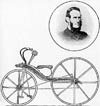Birth of the Bicycle

|
The bicycle evolved from a little wooden horse that had a fixed front wheel. This was invented in France in the 1790's. The only problem was that you could only manuever the bike with your feet. This was due to the bike not having any pedals and the fixed front wheel prevented it from being steered. This seems to be taking on a modern shape of basically an oversized scooter.
|

|
The bicycle was improved in Germany in 1817 by a baron Karl von Drais. Drais developed a steerable front wheel to replace the fixed one. He liked to refer to this upgraded means of transportation as a "hobby horse".
|

|
Baron Karl von Drais's creation was improved upon even further in 1839 by Kilpatrick Macmillan, who was a blacksmith from Scotland. Macmillan was the first to introduce a rear drive bike that used a treadle and rod for the rear driving mechanism. To this point bikes still had metal wheels until inventor R. W. Thompson came up with the idea of a pneumatic tube.
|

|
The bicycle boom began to take off when the French inventors Earnest and Pierre Michaux added cranks and pedals to the model. The larger front wheel that was created made the bicycle faster but less stable.
|

|
The next development that was made to the bike came about in England in the 1880's. In this era the safety bicycle was invented by James Starley of the Coventry Sewing Machine Company. This particular bike had a chain drive, variable gears, wire-spoked wheels, cable controls, sprocket driving rear wheel and equal size tires. This model of the bike is the more conventional design used today.
|
|
As the years passed by, the bicycle saw major developments in the addition of pneumatic tires, two and three speed hub gears, and derailleur gears in the respective early 1880's to the late 1890's. The derailleur gears were the last major innovation of bicycle design until the 1970's when bicycles became more aerodynamic and used more unconventional frames. The bicycle is a cost efficient and extremely popular mode of transportation all over the world. In some remote locations it is the only means of transportation. This is an invention that will not go away for a long time.
|
|
|